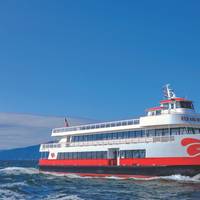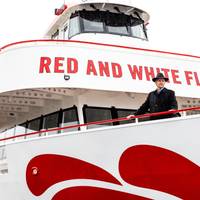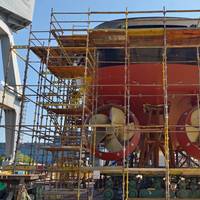Red and White and Green All Over

INSIGHTS: Thomas C. Escher, Chairman, Red and White FleetIn 1960, Tom Escher, the grandson of the founder and now the current owner, started working as a sweeper and a mechanics helper on the Red and White vessels. In 1997, Escher purchased the Red and White Fleet, becoming the third generation of the family to own and operate the business. In September 2018, Red and White Fleet welcomed Enhydra, the newest and largest addition to the fleet. Enhydra is the first 600-passenger hybrid-drive vessel operating in the United States.
OP/ED: The Capital Construction Fund

How to make the Capital Construction Fund work for all vessel owners and operators.The Red and White Fleet is a passenger vessel operator on San Francisco bay with roots back to 1892. We make no secret of the fact that we want to build new vessels with zero environmental signatures, all in an effort to increase employment for shipyard workers, provide new jobs for US mariners, and provide a training ground to support the growth of the U.S. flag deep sea ships. That mission is, today, unnecessarily difficult. The reasons why are easy to see.Not too long ago, H.
The 2007 Act: Highways to Waterways

The Energy Independence and Security Act of 2007 (the 2007 Act) authorized a Short Sea Transportation (SST) Program. As passed by the House, the legislation would have authorized $2 billion for the Maritime Administration (MARAD) Title XI Program and have extended the Capital Construction Fund Program (CCF or Program) to shipyards and operators building and operating vessels in SST services nationwide. Mr. Oberstar and his Congressional co-sponsors were confident that with their proposals in place, the much-discussed use of U.S.
Column: MarAd's CCF: Orphan Child Or Financing Solution?
By H. Fulbright & Jaworski L.L.P. When the Congress returns to Washington in September, the attention of the Members and of industry representatives will be focused on renewing authorizations for two important maritime programs, the MARAD Title XI Program, and the MARAD/DOD Military Security Program. However, there is a third MARAD program that is at least equally deserving of this September's attention, it is MarAd's Capital Construction Fund ("CCF") Program. 1. CCF Tax Deferral Program: History, Scope & Terms. The CCF Program traces its history to the Revenue Act of 1920. Title VI of the Merchant Marine Act, 1936 ("1936 Act") authorized the creation of "regular" and "special" reserve funds into which U.S. citizen liner operators, that were engaged in providing U.S.
From Small Commercial Shipyard to Premier
Local and state dignitaries convened on the Monmouth County waterfront to take part in the christening of the Gladding-Hearn built M/V Seastreak New Jersey, a 141-ft. (42.9-m), 400 passenger high speed catamaran which will provide daily commuter service from Atlantic Highlands, and Highlands, N.J., to Pier 11 (Wall Street) and East 34th Street in Manhattan. According to Geoffrey Ede of SeaStreak America, Inc., Seastreak New Jersey and its sister ship Seastreak New York are the fastest diesel powered ferries in the New York Harbor today with service speeds of approximately 45 mph. Our outstanding commuter service into New York will…
U.S. Shipbuilding: Prospects Abound, but Where’s the Money?
While the U.S. commercial shipbuilding industry outperformed the U.S. economy between 1992 and 2001, this period witnessed the construction of barely a dozen large ocean going vessels for our U.S. domestic trades with an aggregate cost of not much more than $500 million. In contrast, U. S. national transportation needs for the current decade will require the construction of four to five dozen such commercial vessels which, taken together with the building of smaller vessels to meet our other domestic needs, will involve shipbuilding contracts in excess of $6 to $7 billion. The majority of this work is federally mandated by the Oil Pollution Act of 1990, or involves the replacement of vessels in our U.S. non-contiguous trades that have reached the end of their useful lives.
MarAd’s Schubert: Building a Better U.S. Business
In part one of a two-part series, William G. Schubert, the new U.S. Maritime Administrator (MarAd) speaks with H. Clayton Cook, Jr. about the current standing and future direction of maritime activities in the United States. Mr. Administrator, this interview is being conducted for a piece that will be published in the August 2002 issue of Maritime Reporter and Engineering News, the largest magazine of general circulation in the maritime community. So, we have a good many readers who are interested in what you are doing. Your interview will be headlined on the magazine cover. And, we are very pleased that you have agreed to speak with us today. Cook: Would you tell our readers about yourself and life in Washington as the Maritime Administrator?
Editor's Note
Most of you might naturally assume that this is a recent quote from a high ranking shipyard, government or other informed source regarding the current status of the U.S. marine industry. Wrong! This quote is attributed to the opinion of Captain C.A. McAllister, president of the American Bureau of Shipping, published in the January 1, 1928 edition of Marine Age magazine. This, and something my five-year-old son said recently, struck a chord within me regarding the challenges facing the U.S. ship and boatbuilding industry. Upon coming home from the beach one hot August day, Shane, upon inspecting his “Adidas” sandals, said, “It says that these were made in Indonesia ... I thought everything was made in China.” From the mouths of babes.
Letter to the Editor
Clayton Cook's article on the U.S. shipbuilding market was a thoughtful review, as one would expect from such a knowledgeable source whose contribution and commitment to the marine sector is well known. His review of the non-contiguous liner trades characterized the Puerto Rico fleet as "antique," and accurate description of the self-propelled vessels serving the trade. That section, however, did not mention the tug/barges now serving the Puerto Rico lane. Today the majority of the marine freight moving between the mainland and Puerto Rico moves on tug/barge systems. These tug/barge systems are newer than the self-propelled vessels. In our own case, the weighed average age of our fleet is some six years or one-fifth that of the self-propelled vessels in the trade.
PVA:Moving Cargo, Passengers to the Water
As the U.S. Department of Transportation works to develop transportation policies to meet 21st Century needs, perhaps the most vexing problems faced are those associated with traffic congestion on the Interstate highways which parallel our Atlantic, Pacific and Gulf coastlines. Interstate 95, I-5 and I-10 carry automobile and truck traffic far beyond their design capacities. In the major metropolitan areas, which these highways intersect, the combination of interstate and local traffic increasingly slows vehicle movements to a crawl. More traffic is on the way. Additional highway lanes and intersections will not solve these problems. Properly fashioned waterborne trailer and container services and passenger ferry operations can and should.






